airbag off Seat Alhambra 2011 Owner's Manual
[x] Cancel search | Manufacturer: SEAT, Model Year: 2011, Model line: Alhambra, Model: Seat Alhambra 2011Pages: 385, PDF Size: 7.92 MB
Page 12 of 385
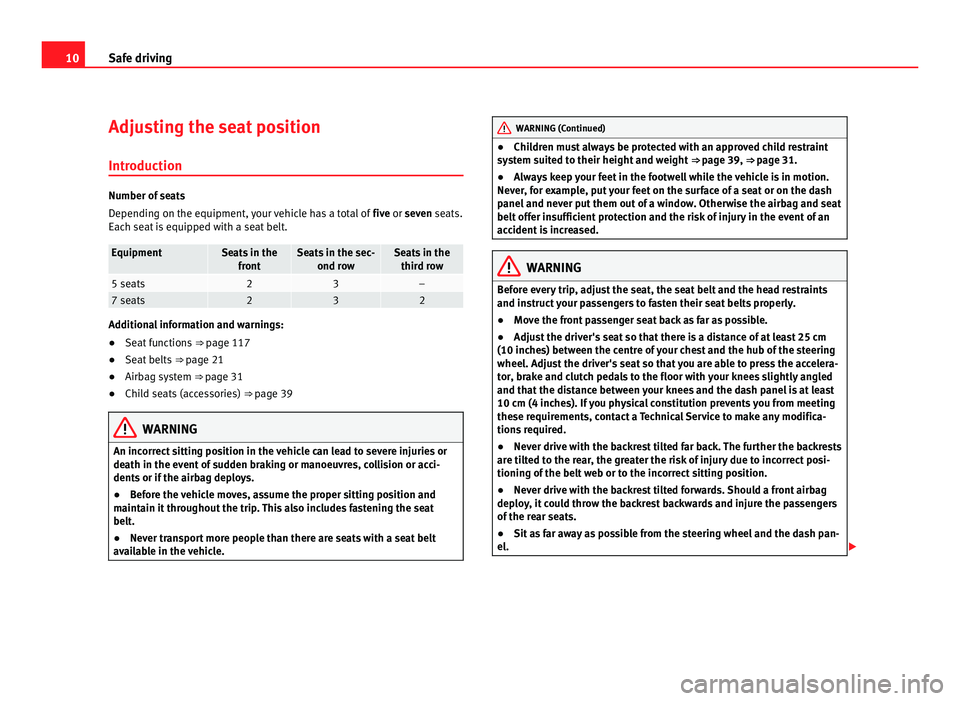
10
Safe driving
Adjusting the seat position
Introduction Number of seats
Dependin
g on the equipment,
your vehicle has a total of five or seven seats.
Each seat is equipped with a seat belt. Equipment Seats in the
front Seats in the sec-
ond ro w Seats in the
third r o
w 5 seats 2 3 –
7 seats 2 3 2
Additional information and warnings:
●
Seat functions ⇒ page 117
● Se
at belts ⇒ page 21
● Airb
ag system ⇒ page 31
● Chi
ld seats (accessories) ⇒ page 39WARNING
An incorrect sitting position in the vehicle can lead to severe injuries or
death in the ev ent
of sudden braking or manoeuvres, collision or acci-
dents or if the airbag deploys.
● Before the vehicle moves, assume the proper sitting position and
maintain it
throughout the trip. This also includes fastening the seat
belt.
● Never transport more people than there are seats with a seat belt
avail
able in the vehicle. WARNING (Continued)
● Children must always be protected with an approved child restraint
sy s
tem suited to their height and weight ⇒ page 39, ⇒ page 31.
● Always keep your feet in the footwell while the vehicle is in motion.
Never, f
or example, put your feet on the surface of a seat or on the dash
panel and never put them out of a window. Otherwise the airbag and seat
belt offer insufficient protection and the risk of injury in the event of an
accident is increased. WARNING
Before every trip, adjust the seat, the seat belt and the head restraints
and ins truct
your passengers to fasten their seat belts properly.
● Move the front passenger seat back as far as possible.
● Adjust the driver's seat so that there is a distance of at least 25 cm
(10 inches) betw
een the centre of your chest and the hub of the steering
wheel. Adjust the driver's seat so that you are able to press the accelera-
tor, brake and clutch pedals to the floor with your knees slightly angled
and that the distance between your knees and the dash panel is at least
10 cm (4 inches). If you physical constitution prevents you from meeting
these requirements, contact a Technical Service to make any modifica-
tions required.
● Never drive with the backrest tilted far back. The further the backrests
are tilt
ed to the rear, the greater the risk of injury due to incorrect posi-
tioning of the belt web or to the incorrect sitting position.
● Never drive with the backrest tilted forwards. Should a front airbag
deploy
, it could throw the backrest backwards and injure the passengers
of the rear seats.
● Sit as far away as possible from the steering wheel and the dash pan-
el.
Page 13 of 385
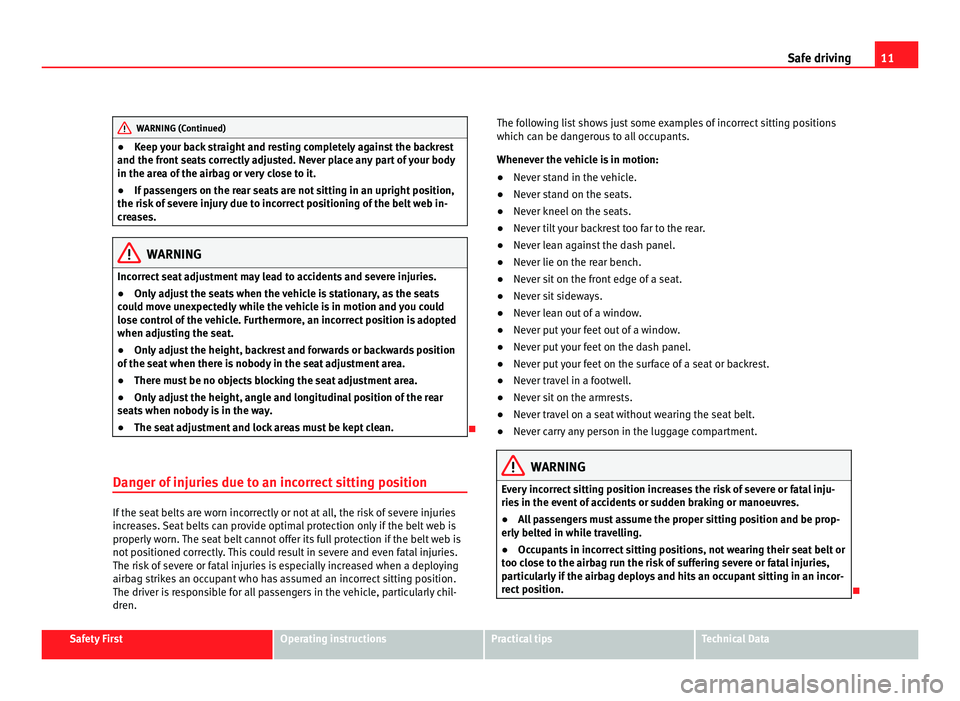
11
Safe driving WARNING (Continued)
● Keep your back straight and resting completely against the backrest
and the fr ont
seats correctly adjusted. Never place any part of your body
in the area of the airbag or very close to it.
● If passengers on the rear seats are not sitting in an upright position,
the risk of
severe injury due to incorrect positioning of the belt web in-
creases. WARNING
Incorrect seat adjustment may lead to accidents and severe injuries.
● Only adjust the seats when the vehicle is stationary, as the seats
cou l
d move unexpectedly while the vehicle is in motion and you could
lose control of the vehicle. Furthermore, an incorrect position is adopted
when adjusting the seat.
● Only adjust the height, backrest and forwards or backwards position
of the seat
when there is nobody in the seat adjustment area.
● There must be no objects blocking the seat adjustment area.
● Only adjust the height, angle and longitudinal position of the rear
seats
when nobody is in the way.
● The seat adjustment and lock areas must be kept clean.
Danger of injuries due to an incorrect sitting position If the seat belts are worn incorrectly or not at all, the risk of severe injuries
incr
e
ases. Seat belts can provide optimal protection only if the belt web is
properly worn. The seat belt cannot offer its full protection if the belt web is
not positioned correctly. This could result in severe and even fatal injuries.
The risk of severe or fatal injuries is especially increased when a deploying
airbag strikes an occupant who has assumed an incorrect sitting position.
The driver is responsible for all passengers in the vehicle, particularly chil-
dren. The following list shows just some examples of incorrect sitting positions
which can be d
angerous to all occupants.
Whenever the vehicle is in motion:
● Never stand in the vehicle.
● Never stand on the seats.
● Never kneel on the seats.
● Never tilt your backrest too far to the rear.
● Never lean against the dash panel.
● Never lie on the rear bench.
● Never sit on the front edge of a seat.
● Never sit sideways.
● Never lean out of a window.
● Never put your feet out of a window.
● Never put your feet on the dash panel.
● Never put your feet on the surface of a seat or backrest.
● Never travel in a footwell.
● Never sit on the armrests.
● Never travel on a seat without wearing the seat belt.
● Never carry any person in the luggage compartment. WARNING
Every incorrect sitting position increases the risk of severe or fatal inju-
ries in the ev
ent of accidents or sudden braking or manoeuvres.
● All passengers must assume the proper sitting position and be prop-
erly belted in whi
le travelling.
● Occupants in incorrect sitting positions, not wearing their seat belt or
too clo
se to the airbag run the risk of suffering severe or fatal injuries,
particularly if the airbag deploys and hits an occupant sitting in an incor-
rect position.
Safety First Operating instructions Practical tips Technical Data
Page 15 of 385
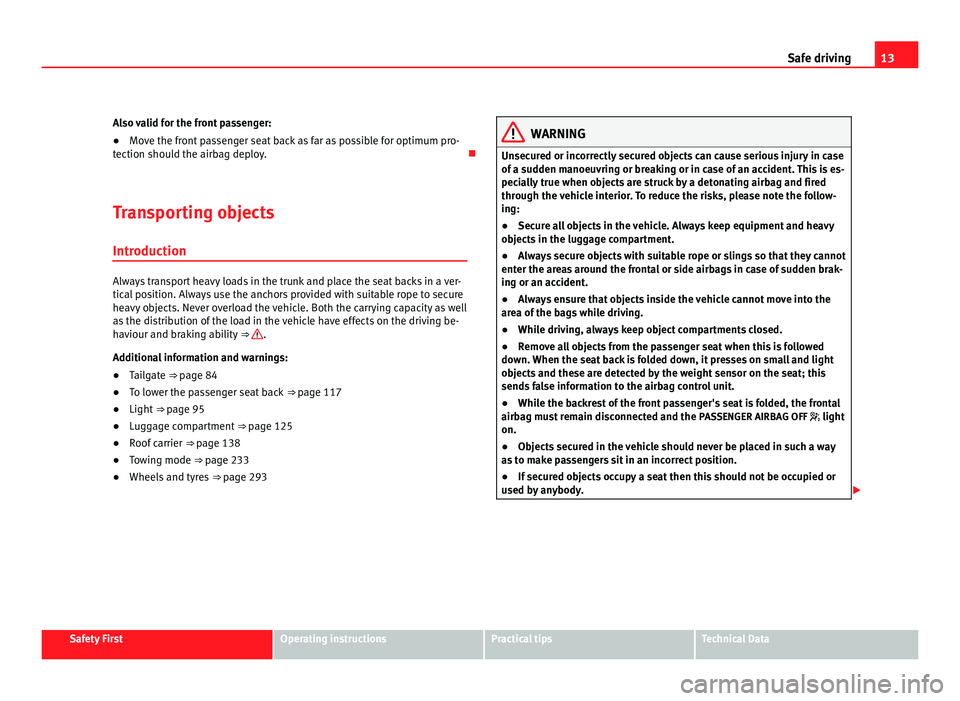
13
Safe driving
Also valid for the front passenger:
● Move the front passenger seat back as far as possible for optimum pro-
tection shou l
d the airbag deploy.
Transporting objects Introduction Always transport heavy loads in the trunk and place the seat backs in a ver-
tical
po
sition. Always use the anchors provided with suitable rope to secure
heavy objects. Never overload the vehicle. Both the carrying capacity as well
as the distribution of the load in the vehicle have effects on the driving be-
haviour and braking ability ⇒ .
Addition a
l information and warnings:
● Tailgate ⇒ page 84
● T
o lower the passenger seat back ⇒ page 117
● Light
⇒ page 95
● Lug
gage compartment ⇒ page 125
● R
oof carrier ⇒ page 138
● T
owing mode ⇒ page 233
● Wheel
s and tyres ⇒ page 293 WARNING
Unsecured or incorrectly secured objects can cause serious injury in case
of a s ud
den manoeuvring or breaking or in case of an accident. This is es-
pecially true when objects are struck by a detonating airbag and fired
through the vehicle interior. To reduce the risks, please note the follow-
ing:
● Secure all objects in the vehicle. Always keep equipment and heavy
obj
ects in the luggage compartment.
● Always secure objects with suitable rope or slings so that they cannot
enter the are
as around the frontal or side airbags in case of sudden brak-
ing or an accident.
● Always ensure that objects inside the vehicle cannot move into the
area of
the bags while driving.
● While driving, always keep object compartments closed.
● Remove all objects from the passenger seat when this is followed
down. When the se
at back is folded down, it presses on small and light
objects and these are detected by the weight sensor on the seat; this
sends false information to the airbag control unit.
● While the backrest of the front passenger's seat is folded, the frontal
airbag mus
t remain disconnected and the PASSENGER AIRBAG OFF light
on.
● Objects secured in the vehicle should never be placed in such a way
as t
o make passengers sit in an incorrect position.
● If secured objects occupy a seat then this should not be occupied or
used by
anybody. Safety First Operating instructions Practical tips Technical Data
Page 23 of 385
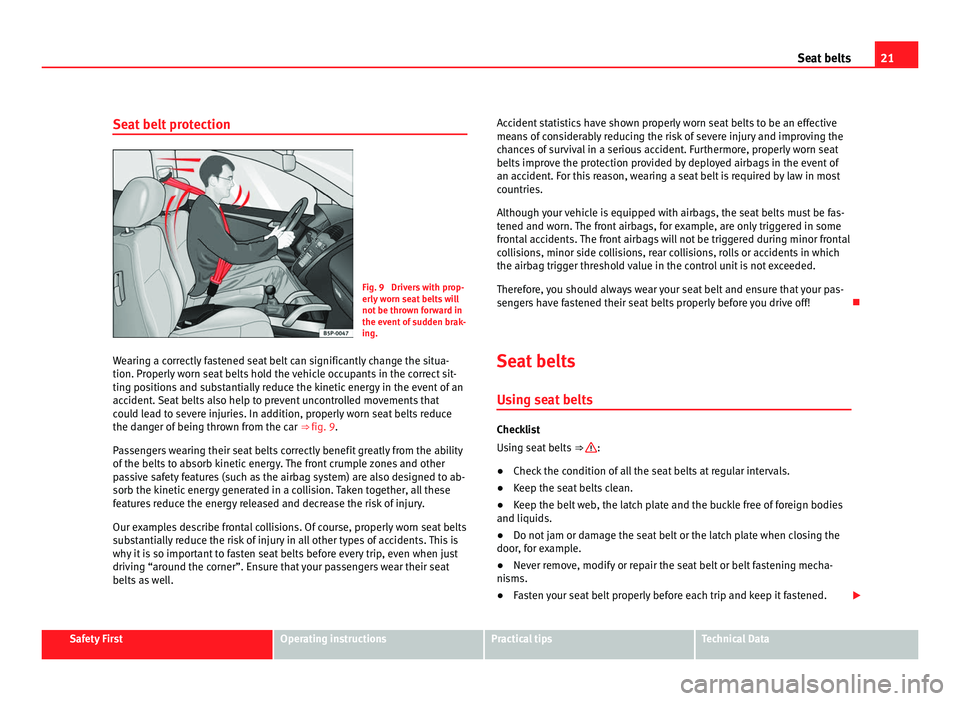
21
Seat belts
Seat belt protection Fig. 9 Drivers with prop-
erly w
orn se
at belts will
not be thrown forward in
the event of sudden brak-
ing.
Wearing a correctly fastened seat belt can significantly change the situa-
tion. Properly w
orn seat belts hold the vehicle occupants in the correct sit-
ting positions and substantially reduce the kinetic energy in the event of an
accident. Seat belts also help to prevent uncontrolled movements that
could lead to severe injuries. In addition, properly worn seat belts reduce
the danger of being thrown from the car ⇒ fig. 9.
Passengers wearing their seat belts correctly benefit greatly from the ability
of the belts to absorb kinetic energy. The front crumple zones and other
passive safety features (such as the airbag system) are also designed to ab-
sorb the kinetic energy generated in a collision. Taken together, all these
features reduce the energy released and decrease the risk of injury.
Our examples describe frontal collisions. Of course, properly worn seat belts
substantially reduce the risk of injury in all other types of accidents. This is
why it is so important to fasten seat belts before every trip, even when just
driving “around the corner”. Ensure that your passengers wear their seat
belts as well. Accident statistics have shown properly worn seat belts to be an effective
means
of considerably reducing the risk of severe injury and improving the
chances of survival in a serious accident. Furthermore, properly worn seat
belts improve the protection provided by deployed airbags in the event of
an accident. For this reason, wearing a seat belt is required by law in most
countries.
Although your vehicle is equipped with airbags, the seat belts must be fas-
tened and worn. The front airbags, for example, are only triggered in some
frontal accidents. The front airbags will not be triggered during minor frontal
collisions, minor side collisions, rear collisions, rolls or accidents in which
the airbag trigger threshold value in the control unit is not exceeded.
Therefore, you should always wear your seat belt and ensure that your pas-
sengers have fastened their seat belts properly before you drive off!
Seat belts Usin
g seat belts Checklist
Us
in
g seat belts ⇒ :
● Check the condition of all the seat belts at regular intervals.
● Keep the seat belts clean.
● Keep the belt web, the latch plate and the buckle free of foreign bodies
and liquid s.
● Do not
jam or damage the seat belt or the latch plate when closing the
door, for e
xample.
● Never remove, modify or repair the seat belt or belt fastening mecha-
nisms.
● Fa
sten your seat belt properly before each trip and keep it fastened. Safety First Operating instructions Practical tips Technical Data
Page 32 of 385
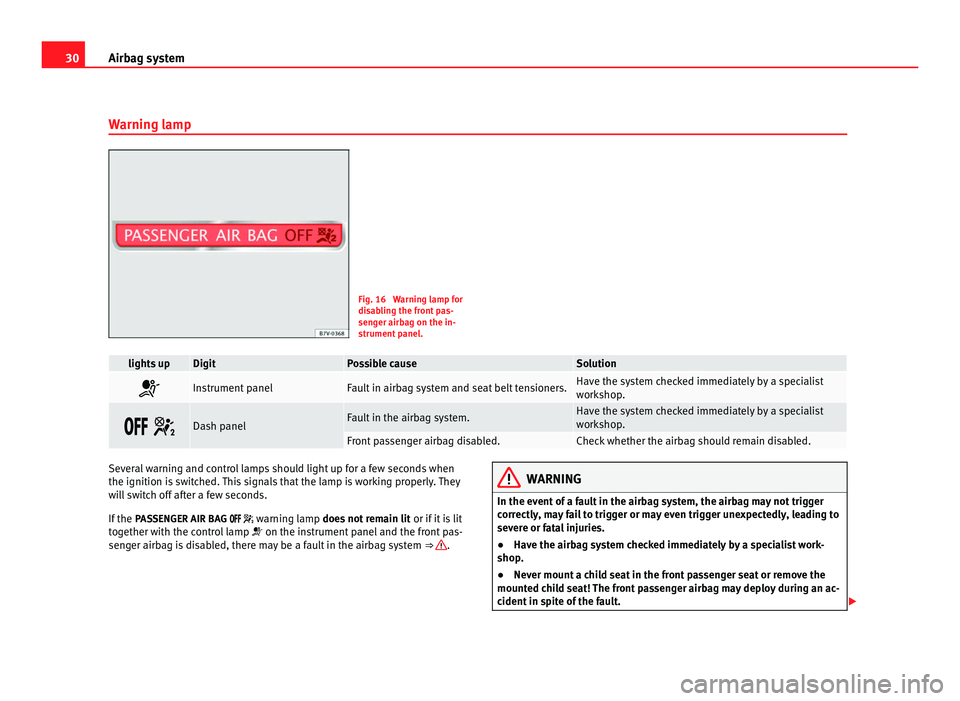
30
Airbag system
Warning lamp Fig. 16 Warning lamp for
dis
ab
ling the front pas-
senger airbag on the in-
strument panel. lights up Digit Possible cause Solution
Instrument panel Fault in airbag system and seat belt tensioners. Have the system checked immediately by a specialist
work
shop
. Dash panel Fault in the airbag system. Have the system checked immediately by a specialist
work
shop
. Front passenger airbag disabled. Check whether the airbag should remain disabled.
Several warning and control lamps should light up for a few seconds when
the ignition is
sw
itched. This signals that the lamp is working properly. They
will switch off after a few seconds.
If the PASSENGER AIR BAG warning lamp does not remain lit or if it is lit
together with the control lamp on the instrument panel and the front pas-
senger airbag is disabled, there may be a fault in the airbag system ⇒ . WARNING
In the event of a fault in the airbag system, the airbag may not trigger
corr ectly
, may fail to trigger or may even trigger unexpectedly, leading to
severe or fatal injuries.
● Have the airbag system checked immediately by a specialist work-
shop.
● Never mou
nt a child seat in the front passenger seat or remove the
mounted c
hild seat! The front passenger airbag may deploy during an ac-
cident in spite of the fault.
Page 33 of 385
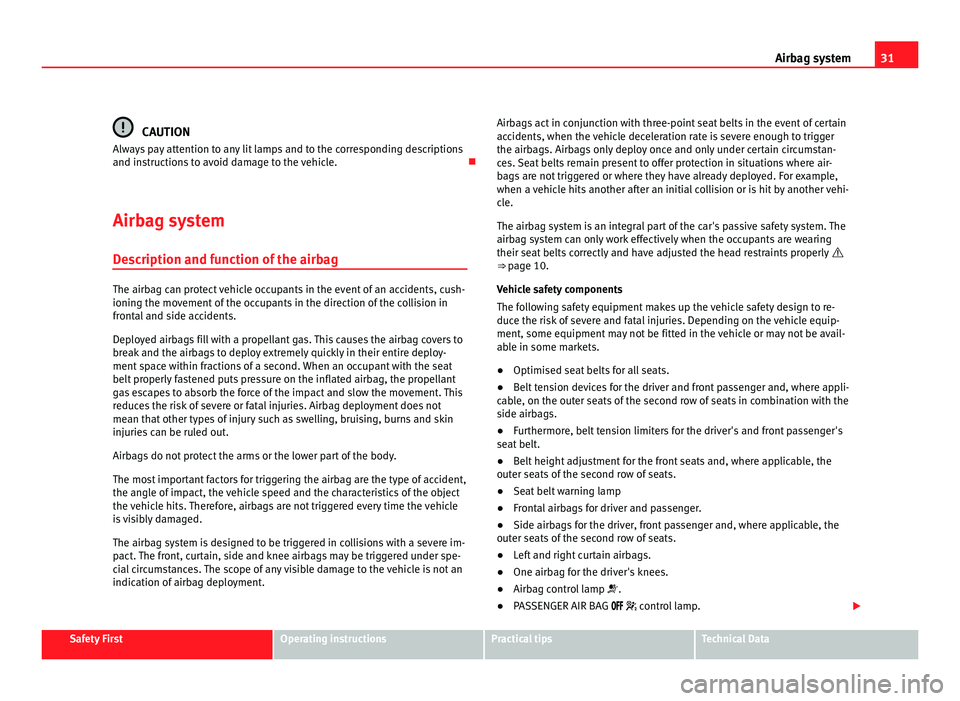
31
Airbag system CAUTION
Always pay attention to any lit lamps and to the corresponding descriptions
and ins truction
s to avoid damage to the vehicle.
Airbag system Des
cription and function of the airbag The airbag can protect vehicle occupants in the event of an accidents, cush-
ioning the mo
v
ement of the occupants in the direction of the collision in
frontal and side accidents.
Deployed airbags fill with a propellant gas. This causes the airbag covers to
break and the airbags to deploy extremely quickly in their entire deploy-
ment space within fractions of a second. When an occupant with the seat
belt properly fastened puts pressure on the inflated airbag, the propellant
gas escapes to absorb the force of the impact and slow the movement. This
reduces the risk of severe or fatal injuries. Airbag deployment does not
mean that other types of injury such as swelling, bruising, burns and skin
injuries can be ruled out.
Airbags do not protect the arms or the lower part of the body.
The most important factors for triggering the airbag are the type of accident,
the angle of impact, the vehicle speed and the characteristics of the object
the vehicle hits. Therefore, airbags are not triggered every time the vehicle
is visibly damaged.
The airbag system is designed to be triggered in collisions with a severe im-
pact. The front, curtain, side and knee airbags may be triggered under spe-
cial circumstances. The scope of any visible damage to the vehicle is not an
indication of airbag deployment. Airbags act in conjunction with three-point seat belts in the event of certain
accidents, when the
vehicle deceleration rate is severe enough to trigger
the airbags. Airbags only deploy once and only under certain circumstan-
ces. Seat belts remain present to offer protection in situations where air-
bags are not triggered or where they have already deployed. For example,
when a vehicle hits another after an initial collision or is hit by another vehi-
cle.
The airbag system is an integral part of the car's passive safety system. The
airbag system can only work effectively when the occupants are wearing
their seat belts correctly and have adjusted the head restraints properly
⇒ page 10.
Vehicle safety components
The following safety equipment makes up the vehicle safety design to re-
duce the risk of severe and fatal injuries. Depending on the vehicle equip-
ment, some equipment may not be fitted in the vehicle or may not be avail-
able in some markets.
● Optimised seat belts for all seats.
● Belt tension devices for the driver and front passenger and, where appli-
cabl
e, on the outer seats of the second row of seats in combination with the
side airbags.
● Furthermore, belt tension limiters for the driver's and front passenger's
seat belt
.
● Belt height adjustment for the front seats and, where applicable, the
outer seats
of the second row of seats.
● Seat belt warning lamp
● Frontal airbags for driver and passenger.
● Side airbags for the driver, front passenger and, where applicable, the
outer seats
of the second row of seats.
● Left and right curtain airbags.
● One airbag for the driver's knees.
● Airbag control lamp .
● PASSENGER AIR BAG contro
l lamp. Safety First Operating instructions Practical tips Technical Data
Page 34 of 385
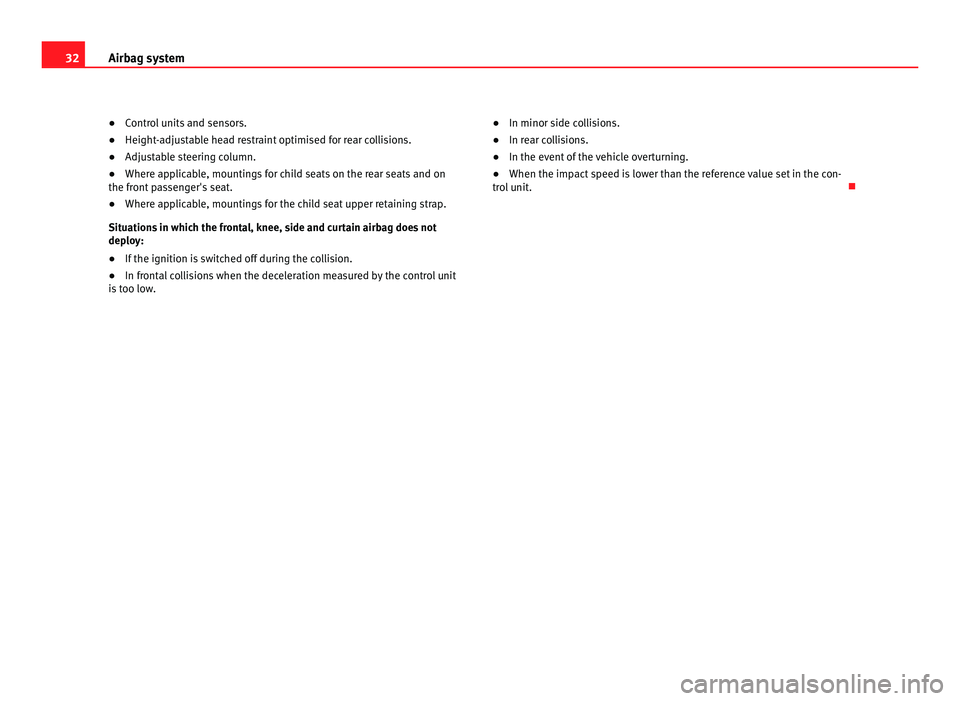
32
Airbag system
● Control units and sensors.
● Height -
adjustable head restraint optimised for rear collisions.
● Adjustable steering column.
● Where applicable, mountings for child seats on the rear seats and on
the front p
assenger's seat.
● Where applicable, mountings for the child seat upper retaining strap.
Situations
in which the frontal, knee, side and curtain airbag does not
deploy:
● If the ignition is switched off during the collision.
● In frontal collisions when the deceleration measured by the control unit
is t
oo low. ●
In minor side co
llisions.
● In rear collisions.
● In the event of the vehicle overturning.
● When the impact speed is lower than the reference value set in the con-
trol
unit.
Page 37 of 385
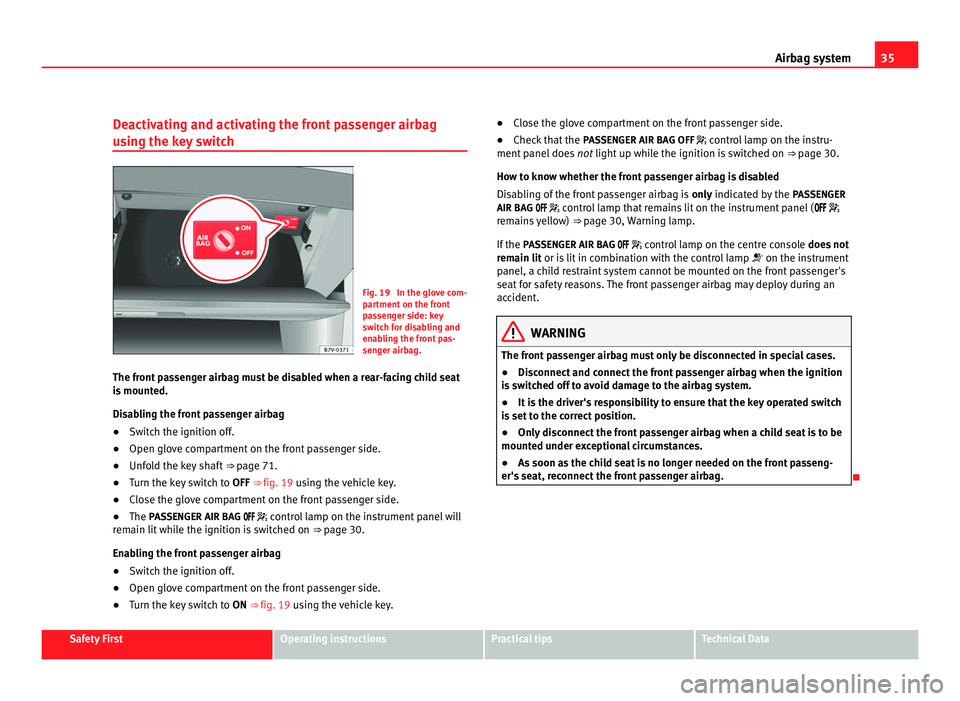
35
Airbag system
Deactivating and activating the front passenger airbag
us in
g the key switch Fig. 19 In the glove com-
par
tment
on the front
passenger side: key
switch for disabling and
enabling the front pas-
senger airbag.
The front passenger airbag must be disabled when a rear-facing child seat
is mou
nted.
Disabling the front passenger airbag
● Switch the ignition off.
● Open glove compartment on the front passenger side.
● Unfold the key shaft ⇒ page 71.
● T
urn the key switch to OFF ⇒ fig. 19 usin
g the vehicle key.
● Close the glove compartment on the front passenger side.
● The PASSENGER AIR BAG
control lamp on the instrument panel will
remain lit while the ignition is switched on ⇒ page 30.
Enabling the front passenger airbag
● Switch the ignition off.
● Open glove compartment on the front passenger side.
● Turn the key switch to ON ⇒ fig. 19 u
sing the vehicle key. ●
Close the glove compartment on the front passenger side.
● Check
that the PASS
ENGER AIR BAG OFF control lamp on the instru-
ment panel does not light up while the ignition is switched on ⇒ page 30.
How to know whether the front passenger airbag is disabled
Disabling of the front passenger airbag is only indicated by the PASSENGER
AIR BAG control lamp that remains lit on the instrument panel (
remains yellow) ⇒ page 30, Warning lamp.
If the PASSENGER AIR BAG control lamp on the centre console does not
remain lit or is lit in combination with the control lamp on the instrument
panel, a child restraint system cannot be mounted on the front passenger's
seat for safety reasons. The front passenger airbag may deploy during an
accident. WARNING
The front passenger airbag must only be disconnected in special cases.
● Disconnect and connect the front passenger airbag when the ignition
is sw
itched off to avoid damage to the airbag system.
● It is the driver's responsibility to ensure that the key operated switch
is set
to the correct position.
● Only disconnect the front passenger airbag when a child seat is to be
mounted u
nder exceptional circumstances.
● As soon as the child seat is no longer needed on the front passeng-
er's seat, r
econnect the front passenger airbag.
Safety First Operating instructions Practical tips Technical Data
Page 55 of 385
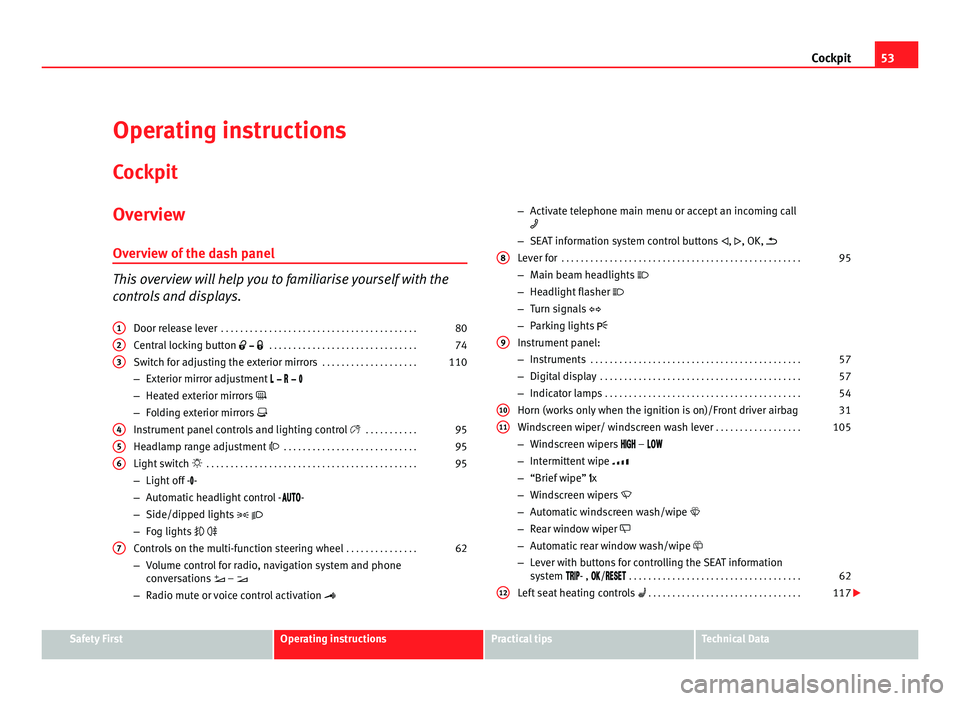
53
Cockpit
Operating instructions Coc kpit
Ov
erview
Overv
iew of the dash panel This overview will help you to familiarise yourself with the
con
tr
ols and displays.
Door release lever . . . . . . . . . . . . . . . . . . . . . . . . . . . . . . . . . . . . . . . . . 80
Central locking button . . . . . . . . . . . . . . . . . . . . . . . . . . . . . . . 74
Switch for adjusting the exterior mirrors . . . . . . . . . . . . . . . . . . . .110
– Exterior mirror adjustment
– Heat
ed exterior mirrors
– Folding exterior mirrors
Instrument panel controls and lighting control . . . . . . . . . . . 95
Headlamp range adjustment . . . . . . . . . . . . . . . . . . . . . . . . . . . . 95
Light switch . . . . . . . . . . . . . . . . . . . . . . . . . . . . . . . . . . . . . . . . . . . . 95
– Light off - -
– Autom
atic headlight control - -
– Side/dipped lights
– Fog lights
Controls on the multi-function steering wheel . . . . . . . . . . . . . . .62
– Volume control for radio, navigation system and phone
con
versations –
– Radio mute or voice control activation
1 2
3
4
5
6
7 –
Activate telephone main menu or accept an incoming call
– SEA
T information system control buttons , , OK,
Lever for . . . . . . . . . . . . . . . . . . . . . . . . . . . . . . . . . . . . . . . . . . . . . . . . . . 95
– Main beam headlights
– Hea
dlight flasher
– Turn signals
– Parking lights
Instrument panel:
– Instruments . . . . . . . . . . . . . . . . . . . . . . . . . . . . . . . . . . . . . . . . . . . . 57
– Digital display . . . . . . . . . . . . . . . . . . . . . . . . . . . . . . . . . . . . . . . . . . 57
– Indicator lamps . . . . . . . . . . . . . . . . . . . . . . . . . . . . . . . . . . . . . . . . . 54
Horn (work
s only when the ignition is on)/Front driver airbag 31
Windscreen wiper/ windscreen wash lever . . . . . . . . . . . . . . . . . .105
– Windscreen wipers –
– Int
ermittent wipe
– “Brief wipe” x
– Windscreen wipers
– Automatic windscreen wash/wipe
– Rear window wiper
– Automatic rear window wash/wipe
– Lever with buttons for controlling the SEAT information
system - , / . . . . . . . . . . . . . . . . . . . . . . . . . . . . . . . . . . . . 62
Left seat heating controls . . . . . . . . . . . . . . . . . . . . . . . . . . . . . . . . 117
8
9
10
11
12
Safety First Operating instructions Practical tips Technical Data
Page 56 of 385
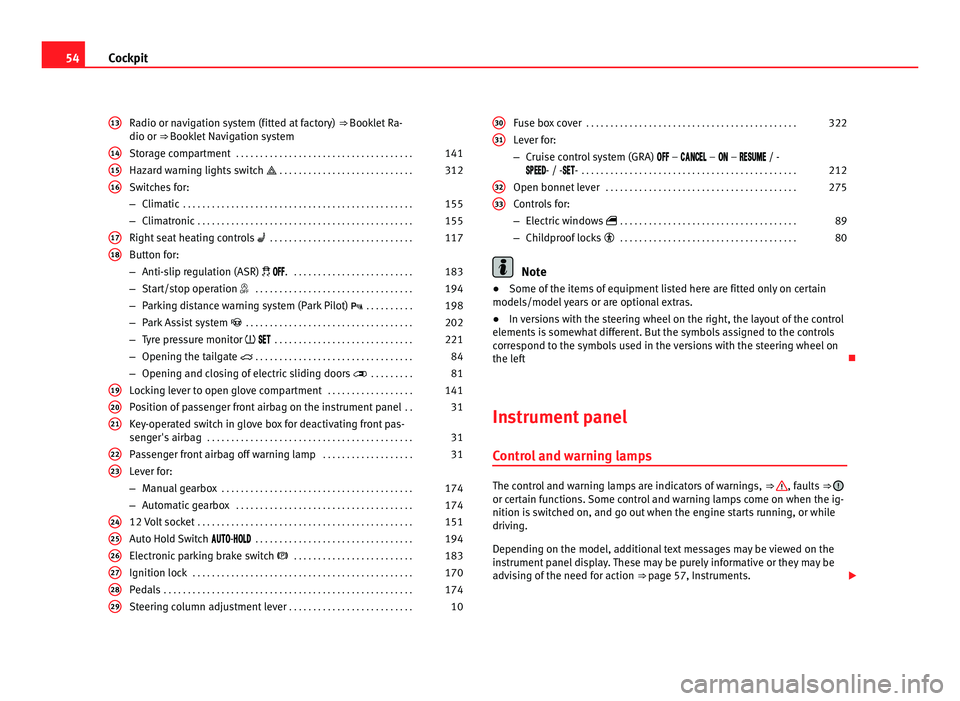
54
Cockpit
Radio or navigation system (fitted at factory) ⇒ Booklet Ra-
dio or ⇒ Booklet Navigation system
Storage compartment . . . . . . . . . . . . . . . . . . . . . . . . . . . . . . . . . . . . . 141
Hazard warning lights switch . . . . . . . . . . . . . . . . . . . . . . . . . . . . 312
Switches for:
– Climatic . . . . . . . . . . . . . . . . . . . . . . . . . . . . . . . . . . . . . . . . . . . . . . . . 155
– C
limatronic . . . . . . . . . . . . . . . . . . . . . . . . . . . . . . . . . . . . . . . . . . . . . 155
Right se
at heating controls . . . . . . . . . . . . . . . . . . . . . . . . . . . . . . 117
Button for:
– Anti-slip r
egulation (ASR) . . . . . . . . . . . . . . . . . . . . . . . . . . 183
– Start/stop operation . . . . . . . . . . . . . . . . . . . . . . . . . . . . . . . . . 194
– Parking distance warning system (Park Pilot) . . . . . . . . . . 198
– Park Assist system . . . . . . . . . . . . . . . . . . . . . . . . . . . . . . . . . . . 202
– Tyre pressure monitor
. . . . . . . . . . . . . . . . . . . . . . . . . . . . . 221
– Opening the tailgate . . . . . . . . . . . . . . . . . . . . . . . . . . . . . . . . . 84
– Opening and closing of electric sliding doors . . . . . . . . . 81
Loc
king lever to open glove compartment . . . . . . . . . . . . . . . . . .141
Position of passenger front airbag on the instrument panel . .31
Key-operated switch in glove box for deactivating front pas-
senger's
airbag . . . . . . . . . . . . . . . . . . . . . . . . . . . . . . . . . . . . . . . . . . . 31
Passenger front airbag off warning lamp . . . . . . . . . . . . . . . . . . .31
Lever for:
– Manual g
earbox . . . . . . . . . . . . . . . . . . . . . . . . . . . . . . . . . . . . . . . . 174
– Automatic gearbox . . . . . . . . . . . . . . . . . . . . . . . . . . . . . . . . . . . . . 174
12 V
olt socket . . . . . . . . . . . . . . . . . . . . . . . . . . . . . . . . . . . . . . . . . . . . . 151
Auto Hold Switch - . . . . . . . . . . . . . . . . . . . . . . . . . . . . . . . . . 194
Electr
onic parking brake switch . . . . . . . . . . . . . . . . . . . . . . . . . 183
Ignition lock . . . . . . . . . . . . . . . . . . . . . . . . . . . . . . . . . . . . . . . . . . . . . . 170
Pedals . . . . . . . . . . . . . . . . . . . . . . . . . . . . . . . . . . . . . . . . . . . . . . . . . . . . 174
Steering column adjustment lever . . . . . . . . . . . . . . . . . . . . . . . . . . 10
13 14
15
16
17
18
19
20
21
22
23
24
25
26
27
28
29 Fuse box cover
. . . . . . . . . . . . . . . . . . . . . . . . . . . . . . . . . . . . . . . . . . . . 322
Lever for:
– Crui se c
ontrol system (GRA) – – – / -
- / -- . . . . . . . . . . . . . . . . . . . . . . . . . . . . . . . . . . . . . . . . . . . . . 212
Open bonnet lever . . . . . . . . . . . . . . . . . . . . . . . . . . . . . . . . . . . . . . . . 275
Controls for:
– Electric w
indows . . . . . . . . . . . . . . . . . . . . . . . . . . . . . . . . . . . . . 89
– Childproof locks . . . . . . . . . . . . . . . . . . . . . . . . . . . . . . . . . . . . . 80 Note
● Some of the items of equipment listed here are fitted only on certain
model s/model
years or are optional extras.
● In versions with the steering wheel on the right, the layout of the control
elements i
s somewhat different. But the symbols assigned to the controls
correspond to the symbols used in the versions with the steering wheel on
the left
Instrument panel Contro
l and warning lamps The control and warning lamps are indicators of warnings,
⇒ , faults
⇒ or certain functions. Some control and warning lamps come on when the ig-
nition is
sw
itched on, and go out when the engine starts running, or while
driving.
Depending on the model, additional text messages may be viewed on the
instrument panel display. These may be purely informative or they may be
advising of the need for action ⇒ page 57, Instruments.
30 31
32
33